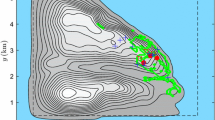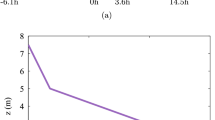Abstract
A streamfunction-vorticity formulation is used to explore the extent to which turbulent and turbulently inviscid solutions to the mean momentum balance explain the mean flow across forest edges and within cavities situated inside dense forested canopies. The turbulent solution is based on the mean momentum balance where first-order closure principles are used to model turbulent stresses. The turbulently inviscid solution retains all the key terms in the mean momentum balance but for the turbulent stress gradients. Both exit and entry versions of the forest edge problem are explored. The turbulent solution is found to describe sufficiently the bulk spatial patterns of the mean flow near the edge including signatures of different length scales reported in canopy transition studies. Next, the ‘clearing inside canopy’ or the so-called ‘cavity’ problem is solved for the inviscid and turbulent solutions and then compared against flume experiments. The inviscid solution describes the bulk flow dynamics in much of the zones within the cavity. In particular, the solution can capture the correct position of the bulk recirculation zone within the cavity, although with a weaker magnitude. The inviscid solution cannot capture the large vertical heterogeneity in the mean velocity above the canopy, as expected. These features are better captured via the first-order closure representation of the turbulent solution. Given the ability of this vorticity formulation to capture the mean pressure variations and the mean advective acceleration terms, it is ideal for exploring the distributions of scalars and roughness-induced flow adjustments on complex topography.












Similar content being viewed by others
References
Amiro BD (1990) Comparison of turbulence statistics within 3 boreal forest canopies. Boundary-Layer Meteorol 51(1–2):99–121
Baldocchi D, Falge E, Gu LH, Olson R, Hollinger D, Running S, Anthoni P, Bernhofer C, Davis K, Evans R, Fuentes J, Goldstein A, Katul G, Law B, Lee XH, Malhi Y, Meyers T, Munger W, Oechel W, Paw KT, Pilegaard K, Schmid HP, Valentini R, Verma S, Vesala T, Wilson K, Wofsy S (2001) FLUXNET: a new tool to study the temporal and spatial variability of ecosystem-scale carbon dioxide, water vapor, and energy flux densities. Bull Am Meteorol Soc 82(11):2415–2434
Belcher SE, Jerram N, Hunt JCR (2003) Adjustment of a turbulent boundary layer to a canopy of roughness elements. J Fluid Mech 488:369–398
Belcher SE, Harman IN, Finnigan JJ (2012) The wind in the willows: flows in forest canopies in complex terrain. Annu Rev Fluid Mech 44(1):479–504
Bergen JD (1975) Air movement in a forest clearing as indicated by smoke drift. Agric Meteorol 15(2):165–179
Campbell GS, Norman JM (1998) An introduction to environmental biophysics. Springer, New York, 286 pp
Cassiani M, Katul GG, Albertson JD (2008) The effects of canopy leaf area index on airflow across forest edges: large-eddy simulation and analytical results. Boundary-Layer Meteorol 126(3):433–460
Dalpe B, Masson C (2009) Numerical simulation of wind flow near a forest edge. J Wind Eng Ind Aerodyn 97(5–6):228–241
Detto M, Katul GG, Siqueira M, Juang JY, Stoy P (2008) The structure of turbulence near a tall forest edge: the backward-facing step flow analogy revisited. Ecol Appl 18(6):1420–1435
Dupont S, Brunet Y (2008) Edge flow and canopy structure: a large-eddy simulation study. Boundary-Layer Meteorol 126(1):51–71
Fesquet C, Dupont S, Drobinski P, Dubos T, Barthlott C (2009) Impact of terrain heterogeneity on coherent structure properties: numerical approach. Boundary-Layer Meteorol 133(1):71–92
Fontan S, Katul GG, Poggi D, Manes C, Ridolfi L (2012) Flume experiments in turbulent flows across gaps of permeable and impermeable boundaries. Boundary-Layer Meteorol 147:21–39
Frank C, Ruck B (2008) Numerical study of the airflow over forest clearings. Forestry 81(3):259–277
Garratt JR (1992) The atmospheric boundary layer. Cambridge University Press, UK, 316 pp
Gavrilov K, Accary G, Morvan D, Lyubimov D, Bessonov O, Meradji S (2010) Large eddy simulation of coherent structures over forest canopy. Turbul Interact 110:143–149
Gavrilov K, Accary G, Morvan D, Lyubimov D, Meradji S, Bessonov O (2011) Numerical simulation of coherent structures over plant canopy. Flow Turbul Combust 86(1):89–111
Holland JZ (1989) On pressure-driven wind in deep forests. J Appl Meteorol 28(12):1349–1355
Huang J, Cassiani M, Albertson JD (2011) Coherent turbulent structures across a vegetation discontinuity. Boundary-Layer Meteorol 140(1):1–22
Irvine MR, Gardiner BA, Hill MK (1997) The evolution of turbulence across a forest edge. Boundary-Layer Meteorol 84(3):467–496
Jackson PS (1981) On the displacement height in the logarithmic velocity profile. J Fluid Mech 111:15–25
Katul GG, Albertson JD (1998) An investigation of higher order closure models for a forested canopy. Boundary-Layer Meteorol 89(1):47–74
Katul GG, Mahrt L, Poggi D, Sanz C (2004) One- and two-equation models for canopy turbulence. Boundary-Layer Meteorol 113(1):81–109
Kelliher FM, Lloyd J, Arneth A, Byers JN, McSeveny T, Milukova I, Grigoriev S, Panfyorov M, Sogatchev A, Varlargin A, Ziegler W, Bauer G, Schulze ED (1998) Evaporation from a central siberian pine forest. J Hydrol 205(3–4):279–296
Lee XH, Shaw RH, Black TA (1994) Modeling the effect of mean pressure-gradient on the mean flow within forests. Agric For Meteorol 68(3–4):201–212
Leuning R, Denmead OT, Miyata A, Kim J (2000) Source/sink distributions of heat, water vapour, carbon dioxide and methane in a rice canopy estimated using lagrangian dispersion analysis. Agric For Meteorol 104(3):233–249
Li ZJ, Lin JD, Miller DR (1990) Air-flow over and through a forest edge—a steady-state numerical-simulation. Boundary-Layer Meteorol 51(1–2):179–197
Liu J, Chen JM, Black TA, Novak MD (1996) E-epsilon modelling of turbulent air flow downwind of a model forest edge. Boundary-Layer Meteorol 77(1):21–44
Manes C, Poggi D, Ridolfi L (2011) Turbulent boundary layers over permeable walls: scaling and near-wall structure. J Fluid Mech 687:141–170
Meyers TP, Baldocchi DD (1991) The budgets of turbulent kinetic-energy and reynolds stress within and above a deciduous forest. Agric For Meteorol 53(3):207–222
Morse AP, Gardiner BA, Marshall BJ (2002) Mechanisms controlling turbulence development across a forest edge. Boundary-Layer Meteorol 103(2):227–251
Nathan R, Katul GG, Horn HS, Thomas SM, Oren R, Avissar R, Pacala SW, Levin SA (2002) Mechanisms of long-distance dispersal of seeds by wind. Nature 418(6896):409–413
Nathan R, Horvitz N, He YP, Kuparinen A, Schurr FM, Katuk GG (2011a) Spread of North American wind-dispersed trees in future environments. Ecol Lett 14(3):211–219
Nathan R, Katul GG, Bohrer G, Kuparinen A, Soons MB, Thompson SE, Trakhtenbrot A, Horn HS (2011b) Mechanistic models of seed dispersal by wind. Theor Ecol 4(2):113–132
Nieveen JP, El-Kilani RMM, Jacobs AFG (2001) Behaviour of the static pressure around a tussock grassland-forest interface. Agric For Meteorol 106(4):253–259
Peltola H (1996) Model computations on wind flow and turning moment for scots pines along the margins of clear-cut areas. For Ecol Manag 83(3):203–215
Poggi D, Porporato A, Ridolfi L, Albertson J, Katul G (2004) The effect of vegetation density on canopy sub-layer turbulence. Boundary-Layer Meteorol 111(3):565–587
Pozrikidis C (2009) Fluid dynamics: theory, computation, and numerical simulation. Springer, New York, 772 pp
Raupach MR, Thom AS (1981) Turbulence in and above plant canopies. Annu Rev Fluid Mech 13:97–129
Raynor GS (1971) Wind and temperature structure in a coniferous forest and a contiguous field. For Sci 17(3):351–361
Rominger JT, Nepf HM (2011) Flow adjustment and interior flow associated with a rectangular porous obstruction. J Fluid Mech 680:636–659
Schlegel F, Stiller J, Bienert A, Maas HG, Queck R, Bernhofer C (2012) Large-eddy simulation of inhomogeneous canopy flows using high resolution terrestrial laser scanning data. Boundary-Layer Meteorol 142(2):223–243
Shaw RH, Schumann U (1992) Large-eddy simulation of turbulent-flow above and within a forest. Boundary-Layer Meteorol 61(1–2):47–64
Stull RB (1990) An introduction to boundary layer meteorology. Kluwer, Boston, 666 pp
Thom AS (1971) Momentum absorption by vegetation. Q J R Meteorol Soc 97(414):414–428
Wang W (2012) An analytical model for mean wind profiles in sparse canopies. Boundary-Layer Meteorol 142(3):383–399
Wilson JD, Flesch TK (1999) Wind and remnant tree sway in forest cutblocks. III. A windflow model to diagnose spatial variation. Agric For Meteorol 93(4):259–282
Wilson NR, Shaw RH (1977) Higher-order closure model for canopy flow. J Appl Meteorol 16(11):1197–1205
Wilson JD, Ward DP, Thurtell GW, Kidd GE (1982) Statistics of atmospheric turbulence within and above a corn canopy. Boundary-Layer Meteorol 24(4):495–519
Yang B, Raupach MR, Shaw RH, Tha K, Paw U, Morse AP (2006) Large-eddy simulation of turbulent flow across a forest edge. Part I: flow statistics. Boundary-Layer Meteorol 120(3):377–412
Acknowledgments
Banerjee and Katul acknowledge the support via cooperative agreement (09-ca-11330140-059) from the United States Forest Service (USFS). Katul also acknowledges the support from the National Science Foundation (NSF) (Grants EAR-1013339, AGS-110227, CBET-103347), the US Department of Agriculture (2011-67003-30222), the Binational Agricultural Research and Development (BARD) Fund (Research Grant Award No. IS-4374-11C), the U.S. Department of Energy through the Office of Biological and Environmental Research (BER) Terrestrial Carbon Processes (TCP) program (DE-SC000697) and the Fulbright Italy distinguished scholars program.
Author information
Authors and Affiliations
Corresponding author
Appendix: Numerical Details of the Problems
Appendix: Numerical Details of the Problems
For solving the systems of equation described in Sect. 2.1, the following algorithm has been used.
-
1.
Initiate \({U}\) and \({W}\) fields. For the \({U}\) field, an exponential profile is used inside the canopy and a logarithmic profile is used above the canopy. \(W\) is set to zero uniformly.
-
2.
Initiate the vorticity \({\omega }\) field using the assumed \({U}\) and \({W}\) fields using Eq. 16.
-
3.
Find the vorticity at the next timestep using Eq. 12.
-
4.
Using the new vorticity, solve the Poisson equation (Eq. 19) with boundary conditions to obtain the streamfunction \({\psi }\) at the new timestep.
-
5.
Compute \({U}\) and \({W}\) from \({\psi }\) using Eqs. 17 and 18.
-
6.
Repeat the steps with the new \({U}\) and \({W}\) until the differences between successive iterations in vorticity falls below a pre-set tolerance value (usually \(5\times 10^{-3}\)).
-
7.
Using the converged vorticity, determine the final updated \({\psi }, {U}\) and \({W}\).
-
8.
Solve the pressure Poisson Eq. 9 to determine \({p}(x,z)\) using boundary conditions defined afterwards.
The numerical details are listed in Table 4 where \(h, x, z, \text{ d }x, \text{ d }z\) indicate canopy height, horizontal and vertical domain sizes, horizontal and vertical grid spacings, respectively. The grid parameters are normalized by canopy height \({h}\). \({C_\mathrm{d}}\) and LAI indicate canopy drag coefficient and the canopy LAI respectively.
Rights and permissions
About this article
Cite this article
Banerjee, T., Katul, G., Fontan, S. et al. Mean Flow Near Edges and Within Cavities Situated Inside Dense Canopies. Boundary-Layer Meteorol 149, 19–41 (2013). https://doi.org/10.1007/s10546-013-9826-x
Received:
Accepted:
Published:
Issue Date:
DOI: https://doi.org/10.1007/s10546-013-9826-x




